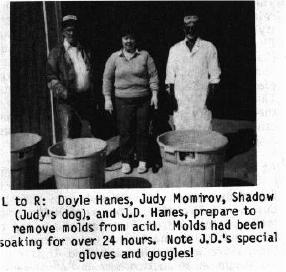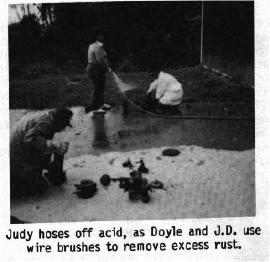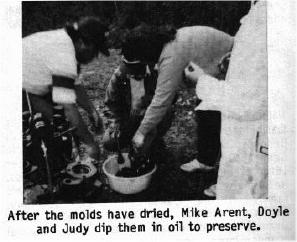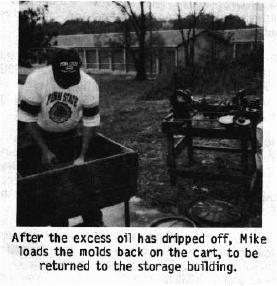End to Rust Dust at the Storage Building
by J. D. Hanes
Issue No. 199 - November 1989
In the last articles from our committee, we told of the "rust dust" involved in the cleaning of the molds, snaps and punties. Well, with some help from one of our dedicated members, we have almost done away with the dust problem.
 During the 1989 Convention, David Rankin, former N.C.C. Board
member, mentioned to me that the company he works for carries an acid
type solution to remove rust from metal pipes. etc. He suggested that
this might be of benefit at the storage building. After receiving
permission from the Board of Directors to try it, David brought some to
the Quarterly Meeting In August, for us to try.
During the 1989 Convention, David Rankin, former N.C.C. Board
member, mentioned to me that the company he works for carries an acid
type solution to remove rust from metal pipes. etc. He suggested that
this might be of benefit at the storage building. After receiving
permission from the Board of Directors to try it, David brought some to
the Quarterly Meeting In August, for us to try.
It was decided that I would take two molds of equal size and condition (rust covered), and try the solution on one, and leave the other one as is. Afterwards, I would show them to Tom Mosser of Mosser Glass Company, for his opinion as to whether the chemical was doing any damage to the mold itself. Tom said that there was no problem with it, as long as we oiled them, or did something after the dip in the chemical, to prevent further rust.
 On Saturday, October 7th, we decided to meet at the N. C. C. storage
building and try this process on a much larger scale. Those who
volunteered to help were: Mike and Cindy Arent; Judy Momirov; Doyle and
JD. Hanes. Oh yes. Judy's dog Shadow Momirov joined us also! As can be
seen in the photos, the weather did cooperate with us and we did get a
lot done.
On Saturday, October 7th, we decided to meet at the N. C. C. storage
building and try this process on a much larger scale. Those who
volunteered to help were: Mike and Cindy Arent; Judy Momirov; Doyle and
JD. Hanes. Oh yes. Judy's dog Shadow Momirov joined us also! As can be
seen in the photos, the weather did cooperate with us and we did get a
lot done.
The molds (of which there were about 8 per trash can) were soaked in the solution for approximately 24 hours. When they came out, they were hosed off and any excess rust was removed very easily with a wire brush.
 After all rust is removed, they are hosed off a final time and set
aside to dry before being dipped and brushed with oil. After the oil is
applied, they are allowed to set while the excess oil drips off, then
their numbers are recorded and they are once again put away in
storage.
After all rust is removed, they are hosed off a final time and set
aside to dry before being dipped and brushed with oil. After the oil is
applied, they are allowed to set while the excess oil drips off, then
their numbers are recorded and they are once again put away in
storage.
Needless to say, this entire process will make cleaning the molds and tools a whole lot easier in the future. This will benefit all members of our club, as we will be able to have a complete inventory of all the items we have from the old Cambridge factory.
 Now, there is one thing that we still need. That is, help from all
of our members. Number one is, of course, time. It may be too cold at
the November Quarterly meeting and March Auction, to work at the
building, but, if anyone would like to help during Convention next
year, or any time, please let me know. We can make arrangements with
others and have a large work party.
Now, there is one thing that we still need. That is, help from all
of our members. Number one is, of course, time. It may be too cold at
the November Quarterly meeting and March Auction, to work at the
building, but, if anyone would like to help during Convention next
year, or any time, please let me know. We can make arrangements with
others and have a large work party.
The second thing that we need is materials. Plastic trash cans, of any size, with lids; oil or grease to coat the molds, buckets for the oil dip; old or new brushes; and rubber gloves. If you could donate any of these items, it would be appreciated.
Again, we hope to keep all of you informed of our progress so that YOUR storage building of glass making items will be as nice as the Museum.
One final note, a big Thank You to Carl Beynon of Cambridge, who brought his tractor to the Museum and leveled off the ground around the front of the storage building; and to Willard Kolb, who planted grass in the area. This will be a big improvement to the grounds of the Museum.
Until next article, keep collecting Cambridge!
